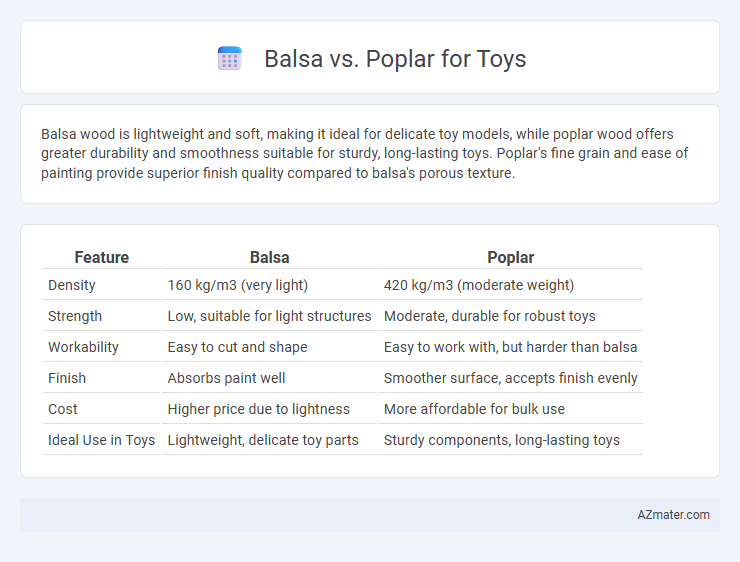Balsa wood is lightweight and soft, making it ideal for delicate toy models, while poplar wood offers greater durability and smoothness suitable for sturdy, long-lasting toys. Poplar's fine grain and ease of painting provide superior finish quality compared to balsa's porous texture.
Table of Comparison
| Feature | Balsa | Poplar |
|---|---|---|
| Density | 160 kg/m3 (very light) | 420 kg/m3 (moderate weight) |
| Strength | Low, suitable for light structures | Moderate, durable for robust toys |
| Workability | Easy to cut and shape | Easy to work with, but harder than balsa |
| Finish | Absorbs paint well | Smoother surface, accepts finish evenly |
| Cost | Higher price due to lightness | More affordable for bulk use |
| Ideal Use in Toys | Lightweight, delicate toy parts | Sturdy components, long-lasting toys |
Introduction: Balsa vs Poplar for Toy Making
Balsa and poplar are popular wood choices for toy making, each offering distinct advantages. Balsa is renowned for its exceptional lightness and softness, making it ideal for intricate, delicate designs. Poplar, on the other hand, provides greater strength and durability while maintaining ease of machining, suitable for toys that require sturdier construction.
Understanding Balsa Wood: Key Characteristics
Balsa wood is a lightweight, soft hardwood known for its exceptional buoyancy and ease of shaping, making it ideal for toy construction that requires delicate detail and minimal weight. Its low density ranges between 100 to 200 kg/m3, providing superior floatation and energy absorption compared to poplar. Balsa's open-cell structure allows for effortless sanding and cutting, enhancing precision in toy manufacturing where smooth finishes and intricate designs are essential.
Poplar Wood: Properties and Features
Poplar wood is a lightweight, moderately strong hardwood with a fine, even texture, making it ideal for toy construction due to its smooth finish and ease of painting. It has a Janka hardness rating of approximately 540, providing sufficient durability while remaining easy to machine and shape. Compared to balsa, poplar offers better impact resistance and dimensional stability, ensuring toys maintain their shape and appearance over time.
Weight Comparison: Balsa vs Poplar
Balsa wood is significantly lighter than poplar, with a density ranging from 100 to 200 kg/m3 compared to poplar's 400 to 560 kg/m3, making balsa the preferred choice for toy construction requiring minimal weight. This low density ensures toys made from balsa are easier for children to handle and less tiring to play with over extended periods. Poplar's higher density provides greater durability but increases the overall weight, which may not be ideal for lightweight toy designs.
Strength and Durability Factors
Balsa wood is extremely lightweight but has lower strength and durability compared to poplar, making it ideal for delicate toy parts that require less structural support. Poplar offers higher density and greater impact resistance, enhancing the toy's longevity and ability to withstand rough handling. For toys requiring robust strength and durability, poplar is the preferable choice, while balsa suits applications prioritizing lightness over toughness.
Workability and Cutting Ease
Balsa wood offers exceptional workability and cutting ease due to its lightweight, soft texture, and low density, allowing quick shaping with minimal effort. Poplar, while denser and harder than balsa, provides moderate workability but requires sharper tools for clean cuts and precise detailing. For toy making, balsa is ideal when intricate, lightweight components are needed, whereas poplar suits more durable pieces that withstand rough handling.
Safety Aspects in Toy Applications
Balsa wood offers superior safety for toy applications due to its lightweight, non-toxic properties, and smooth texture that reduces splinter risk. Poplar, while also non-toxic and commonly used, has a denser grain that may increase the possibility of sharper edges and splinters if not properly finished. Both woods comply with safety standards, but balsa's softness and ease of sanding make it particularly suitable for safe, child-friendly toys.
Cost Differences: Balsa vs Poplar
Balsa wood is significantly more expensive than poplar due to its lightweight properties and premium softness, making it ideal for delicate toy construction. Poplar offers a more cost-effective alternative with greater durability and moderate weight, suitable for sturdier toys. The choice between balsa and poplar largely depends on budget constraints and the desired balance between lightweight design and material strength.
Environmental Impact and Sustainability
Balsa wood offers exceptional lightweight properties but is less sustainable due to slower regrowth and higher demand impacting tropical forests. Poplar wood grows rapidly and is often sourced from managed plantations, making it a more environmentally friendly choice for toy manufacturing. Sustainable harvesting practices and certifications like FSC ensure both woods can minimize ecological footprints in toy production.
Best Uses: Choosing the Right Wood for Your Toy
Balsa wood offers exceptional lightness and softness, making it ideal for delicate toy parts and models requiring easy shaping and fine details. Poplar provides greater strength and durability, perfect for toys expected to withstand rough handling and frequent play. Selecting between balsa and poplar depends on the toy's required balance between weight and toughness, with balsa best suited for lightweight craft toys and poplar preferred for robust, long-lasting toys.

Infographic: Balsa vs Poplar for Toy
 azmater.com
azmater.com